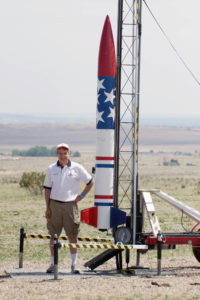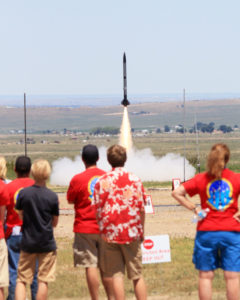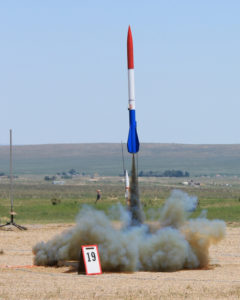High Power Rocketry
The NAR was created in 1957 as an advocate of the model rocketry hobby. Over the past six decades the hobby has grown to encompass rocket motor types and performance unavailable to the modeler at the NAR’s inception. In response to this growth the NAR offers a certification process which permits individuals to purchase and use rocket motors whose physical constraints and performance exceed traditional model rocket boundaries. Rocket motors which exceed model rocketry motor definitions and the models that use these motors are collectively referred to as High Power Rocketry (HPR). HPR is similar to model rocketry with differences that include the propulsion power and weight increase of the model. They use motors in ranges over “G” power and /or weigh more than laws and regulations allow for unrestricted model rockets.
/or weigh more than laws and regulations allow for unrestricted model rockets.
High Power Rocket motors cannot be purchased over the counter by the general consumer and typically are not carried by your average hobby store. They can be mail-ordered or purchased at some launch sites by adult modelers who are High Power Certified. HPR certification is a requirement to purchase and use these motors. The NAR offers a three level certification program for modelers who want to fly high power rockets. These certificate levels will be discussed in detail further in this article. High Power Rockets must also be flown in compliance with their own High Power Rocket Safety Code.
Where Is The Line Between Model and High Power Rocketry?
A rocket exceeds the definition of a Model Rocket under NFPA 1122 and becomes a High Power Rocket under NFPA 1127 if it:
- Uses a motor with more than 160 Newton-seconds of total impulse (an “H” motor or larger) or multiple motors that all together exceed 320 Newton-seconds; or
- Uses a motor with more than 80 Newtons average thrust (see rocket motor coding); or
- Exceeds 125 grams (4.4 ounces) of propellant; or
- Weighs more than 1,500 grams (53 ounces) including motor(s); or
- Uses a hybrid motor or a motor designed to emit sparks; or
- Includes any airframe parts of ductile metal.
In addition, under FAA rules (FAR 101.22), a rocket exceeds the definition of a Class 1 Model Rocket and becomes a Class 2 High Power Rocket if it weighs more than 1500 grams (53 ounces). For additional information on Class 2 Rockets, see the Understanding FAA Regulations page.
Who Regulates High Power Rocketry?
High Power Rockets fall under a code of regulations known as National Fire Protection Association (NFPA) Code 1127. The NFPA’s current rocketry codes were first written in 1995. Many states have adopted these codes by reference through their adoption of NFPA 1. Please check your state’s laws before attempting to launch High Power Rockets.
In addition, you must apply for and receive a Certificate of Waiver or Authorization (COA), commonly called a “Waiver”, from the FAA before launching High Power Rockets. The purpose of a COA is to ensure compatibility of launching Class 2 rockets at a particular site with other uses within a designated airspace. To learn more about a Certificate of Waiver or Authorization and help applying for one, please see the Filing For FAA Launch Authorization page.
How do I get started in High Power Rocketry?
The NAR offers a three tier certification program for adult members who wish to build and fly High Power Rockets. It also offers a HPR Participation Program to its Junior & Leader members (aged 14 to 17). Membership empowers you to apply for this High Power Certification and is free to all applicable NAR members. See descriptions of these certification levels below.
The expectation of the certification program is that members gain experience at each certification level prior to progressing to the next level. This would include building and flying several rockets that use one or more motors of the flyer’s current certification level. Members are encouraged to keep flight logs of their HPR flights to capture successes, failures, and lessons learned. Having this experience log will assist your certification teams when you apply for certification at the next level.
NOTE: The NAR also has a Trained Safety Officer program, which is designed to assist individuals in performing safety officer functions on a High Power Rocket range. A complete set of Technical Reports regarding High Power Rocketry Topics is available.
HPR Certification Information— Jr., Level 1, Level 2, and Level 3
Connect With Local NAR Sections (Clubs)
The NAR is all about having fun with High Power Rockets. We are the oldest and largest sport rocketry organization in the world and our HPR  programs cover ALL of the high power activities you may wish to pursue. We recommend you get together with other HPR flyers in a NAR Section near your location. HPR designing, building, and flying experiences are always more fun when you can share these experiences and learn new techniques with fellow local flyers.
programs cover ALL of the high power activities you may wish to pursue. We recommend you get together with other HPR flyers in a NAR Section near your location. HPR designing, building, and flying experiences are always more fun when you can share these experiences and learn new techniques with fellow local flyers.
Launching High Power Rockets requires more preparation than launching model rockets. Not only is a larger field needed, but FAA clearance must be arranged well in advance of the launch date. There may also be local or state regulatory issues to be addressed before you can fly your first High Power Rocket. This is another good reason to join a NAR Section. Many clubs already have the personnel and experience in making these tedious arrangements, freeing you to concentrate on the actual flying.
Cross C ertification
ertification
NAR members who are currently Tripoli Rocketry Association HPR certified may cross-certify with NAR at the same level by completing the identification portion of a NAR High Power Application and attaching proof of current Tripoli certification (e.g., photocopy of Tripoli consumer confirmation card) to NAR headquarters with a request that their certification level be updated.
NAR HPR certifications, once earned, are valid whenever NAR membership is current, and are reinstated after membership lapses.
Other HPR Resources
HPR Certification Information—Jr., Level 1, Level 2, and Level 3
Filing For FAA Launch Authorization